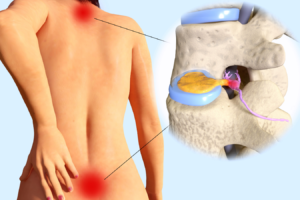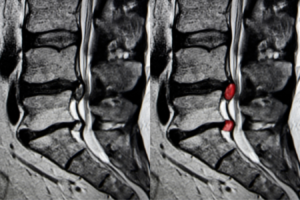 Sciatica is a very common condition, affecting more than 3 million Americans per year. So chances are, you or someone you know has been impacted by this often extremely painful condition. But what exactly is sciatica? What causes it? And how is it treated? Also, what is its connection to a herniated disc (herniated disk)? We discuss all of this and more in the following post.
Sciatica is a very common condition, affecting more than 3 million Americans per year. So chances are, you or someone you know has been impacted by this often extremely painful condition. But what exactly is sciatica? What causes it? And how is it treated? Also, what is its connection to a herniated disc (herniated disk)? We discuss all of this and more in the following post.
What is sciatica?
First, let’s discuss the anatomy. Sciatica is a term commonly used for pain that occurs along the sciatic nerve. The sciatic nerve is the main nerve that is formed in the lower spine or lumbar spine. Furthermore, the sciatic nerve goes from the lumbar spine into the buttock proceeding down into the thigh, knee, calf, and into the foot and ankle. This nerve can be pinched in the lumbar spine most commonly due to a disk (disc) herniation.
 In between each vertebra (spine bones), there are structures known as disks, which act as a cushion between the bones. The makeup of each one of these discs is similar to a jelly doughnut. Each of the discs has a tough outer layer similar to the dough part of a doughnut and a central nucleus layer similar to the jelly in the center of a doughnut. It is this jelly or nucleus, that can herniate through the outer portion of the disc and cause pressure on a nerve. This is commonly known as a herniated, or bulging, disc. The human body has five lumbar bones and five corresponding disks. Disk herniations most commonly occur in the lower lumbar spine.
In between each vertebra (spine bones), there are structures known as disks, which act as a cushion between the bones. The makeup of each one of these discs is similar to a jelly doughnut. Each of the discs has a tough outer layer similar to the dough part of a doughnut and a central nucleus layer similar to the jelly in the center of a doughnut. It is this jelly or nucleus, that can herniate through the outer portion of the disc and cause pressure on a nerve. This is commonly known as a herniated, or bulging, disc. The human body has five lumbar bones and five corresponding disks. Disk herniations most commonly occur in the lower lumbar spine.
How is sciatica related to a herniated disc (disk)?
Often, sciatica and herniated disks are mentioned in the same conversation. So how are they related to one another? To elaborate on the paragraph above, sciatica most commonly occurs when a herniated disc, bone spur on the spine, or narrowing of the spine (spinal stenosis) compresses part of the nerve. As a result, inflammation, pain, and often numbness in the affected leg occur. Simply put, a herniated disk is the most common cause of sciatica.
What are the risk factors and symptoms of sciatica?
Mostly commonly sciatica occurs in patients between the ages of 25 and 65, although we occasionally see the issue outside of that age range. Typically, symptoms include acute (all of a sudden) pain initially in the lower back or buttock. The symptoms are often isolated to one side or the other. Additionally, the pain can move into the buttock and then down the leg. Often, patients can recall an incident that caused the pain. Surprisingly, this can happen from something as simple as bending down or reaching for something.
On the other hand, some patients don’t recall any inciting factors. The symptoms can evolve slowly or become severe very quickly. A lot of patients go to the emergency room or urgent care because of the severity of the pain. Unfortunately, sciatica pain is one of the more severe pains and is often difficult to treat with medications alone. When the sciatic nerve is compressed; three different symptoms can occur. First, patients notice severe unremitting pain. Second, patients can notice numbness and tingling. Lastly, nerve compression can lead to weakness in the leg, foot, and ankle.
 How do you diagnose sciatica and herniated discs?
How do you diagnose sciatica and herniated discs?
So, how do I know if I have sciatica? Typically, we can diagnose sciatica simply based on a patient’s history and a physical exam. We regularly take x-rays in the office, but it is the ALL-IMPORTANT MRI that gives us the definitive answer. An MRI is a non-invasive test that does not involve radiation whereby a patient lays down for about fifteen to twenty-five minutes in an MRI magnet, which produces a very detailed image of the spine. The MRI will tell us exactly if a patient has a disc herniation, as well as the magnitude and location of that herniation. Most patients tolerate the MRI very well. However, for those who are claustrophobic, we offer other options to help them feel comfortable.
How do you treat sciatica & herniated discs?
Conservative Non-Surgical Treatments for Sciatica
Once we diagnose a patient as having a herniated disk, we will discuss all available treatment options with them. First, we will start with conservative treatment options such as anti-inflammatory medications, muscle relaxers, and/or pain medicines when necessary. We also will explore physical therapy or chiropractic care options. Many patients experience significant improvement in their sciatica with these simple measures.
If the symptoms continue despite these measures, we often try something known as an epidural steroid injection (ESI). Steroids are a great anti-inflammatory. The ESI is an in-office procedure monitored with x-ray guidance. We can inject the steroid medication directly into the area of the irritated nerve by the herniated disc to decrease the pain. Sometimes, a series of these injections will be done over the course of four to six weeks depending on a patient’s pain level. More than 50% of patients have significant improvement with conservative treatment and time. For those who continue to have severe pain that affects their quality of life, we may talk about surgery as an option.
Surgical Treatment for Sciatica
For those who continue to have severe pain that affects their quality of life, we may talk about surgery as an option. The surgery most commonly performed for herniated discs is called a microdiscectomy, which is generally an outpatient surgery. The surgery is approximately one hour, whereby the patient is first put to sleep under general anesthesia. Then a small (less than one-inch) incision is made in the lower lumbar spine. The goal of this surgery is to simply remove the herniated fragment to take the pressure off the nerve being compressed. Generally, this is a very low-risk surgery with a high success rate. However, a patient must stick to a few restrictions after this type of surgery for about four to six weeks. Patients that are non-laborers can often go back to work within one to two weeks. However, those that have a labor-intensive job may need to wait six weeks to return. Generally, at six weeks we allow our patients to resume most activities.
In Closing
As always, it is best to speak with your doctor about any minor or severe, and/or prolonged back pain you are experiencing to determine which treatment is best for you. If your insurance requires a pre-authorization, no problem! At Advanced Ortho & Spine, our office takes care of ensuring your insurance authorization after your doctor refers you to us. Contact us or call us at 615.885.0200 to schedule your appointment.
 Dr. Tarek Elalayli is a board-certified orthopaedic spine surgeon, who specializes in treating a full range of spinal conditions. Contact us today for more information or to request an appointment.
Dr. Tarek Elalayli is a board-certified orthopaedic spine surgeon, who specializes in treating a full range of spinal conditions. Contact us today for more information or to request an appointment.
 Mitul Patel, MD is a board-certified orthopaedic spine surgeon, who specializes in treating a full range of spinal conditions. Contact us today for more information or to request an appointment.
Mitul Patel, MD is a board-certified orthopaedic spine surgeon, who specializes in treating a full range of spinal conditions. Contact us today for more information or to request an appointment.

With two locations near Nashville in Mt. Juliet and Hermitage, Advanced Ortho and Spine provides patients with high-quality, personalized care while advancing orthopaedic excellence. Contact us today to learn more or to schedule your appointment.
Disclaimer: This blog provides general information and discussions about health and related subjects. The information and other content provided in this blog, or in any linked materials, are not intended and should not be construed as medical advice, nor is the information a substitute for professional medical expertise or treatment.If you or any other person has a medical concern, you should consult with your healthcare provider or seek other professional medical treatment. Never disregard professional medical advice or delay in seeking it because of something read on this blog or in any linked materials. If you think you may have a medical emergency, call your doctor or emergency services immediately.
The opinions and views expressed on this blog and website have no relation to those of any academic, hospital, health practice, or other institution.